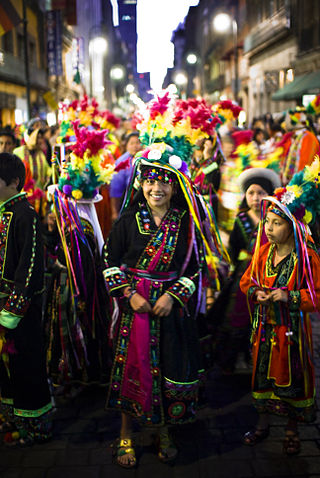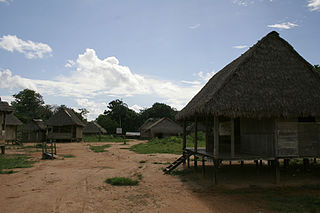Related Research Articles

The languages of Bolivia include Spanish; several dozen indigenous languages, most prominently Aymara, Quechua, Chiquitano, and Guaraní; Bolivian Sign Language ; and languages of immigrants such as Plautdietsch. Indigenous languages and Spanish are official languages of the state according to the 2009 Constitution. The constitution says that all indigenous languages are official, listing 36 specific languages, of which some are extinct. Spanish and Quechua are spoken primarily in the Andes region, Aymara is mainly spoken in the Altiplano around Lake Titicaca, Chiquitano is spoken in the central part of Santa Cruz, and Guaraní is spoken in the southeast on the border with Paraguay.
Bauré is an endangered Arawakan language spoken by only 40 of the thousand Baure people of the Beni Department of northwest of Magdalena, Bolivia. Some Bible portions have been translated into Bauré. Most speakers have been shifting to Spanish.
Reyesano, or Chirigua (Chiriba), is a nearly extinct Tacanan language that was spoken by only a few speakers, including children, in 1961 in Bolivia. It is spoken by the Maropa people who number 4,505 in 2012.
Baures is a village in Iténez Province, Beni Department, in northern Bolivia. It is the capital of Baures Municipality.
Loreto is a smalI municipality in the Beni Department in northern Bolivia, capital of the Marbán Province and Loreto Municipality. In 2001, Loreto had a population of 843.
Moxo is any of the Arawakan languages spoken by the Moxo people of the Llanos de Moxos in northeastern Bolivia. The two extant languages of the Moxo people, Trinitario and Ignaciano, are as distinct from one another as they are from neighboring Arawakan languages. The extinct Magiana was also distinct.

San Joaquín is a small agricultural town in the Beni Department in the Bolivian lowlands.

Totora, Tutura or T'utura is a town in the Carrasco Province of the Cochabamba Department in Bolivia. It is the capital and most-populous place of the Totora Municipality. As of the 2012 census, the population is 1,925. The first settlers were Inca Indians. Totora was officially settled in 1876, and declared a town by the Government of Bolivia in 1894.
Baures Municipality is a municipality of the Beni Department, Bolivia.
San Javier (Beni) is a small town in Bolivia.

Bolivians are people identified with the country of Bolivia. This connection may be residential, legal, historical or cultural. For most Bolivians, several of these connections exist and are collectively the source of their being Bolivian.
Guarayu is a Tupian language of Bolivia that is spoken by the Guarayo people who number 23,910 in 2012.

The Ese Ejja are an indigenous people of Bolivia and Peru, in the southwestern Amazon basin. 1,687 Ese Ejja live in Bolivia, in the Pando and Beni Departments, in the foothills along the Beni and the Madre de Dios Rivers. In Peru, they live along the Tambopata and Heath Rivers, near Puerto Maldonado.
The Machinere are an indigenous people of Brazil, Bolivia, and Peru. They live along the Acre River in Bolivia. In Brazil they mostly live in the Mamoadate Indigenous Territory, although some live in the Chico Mendes Extractivist Reserve, both in Acre.
White Bolivians or European Bolivians are Bolivian people whose ancestry lies within the continent of Europe, most notably Spain and Germany, and to a lesser extent, Italy and Croatia.

The Llanos de Moxos, also known as the Llanos de Mojos and the Beni Savanna, have extensive remains of pre-Columbian agricultural societies scattered over most of Beni Department, Bolivia. The remains testify to a well-organized and numerous indigenous people. This contradicts the traditional view of archaeologists, notably Betty Meggers, who asserted that the Amazon River Basin was not environmentally able to sustain a large population and that its indigenous inhabitants were hunter-gatherer bands or slash-and-burn farmers. In the 1960s, petroleum company geologists and geographer William Denevan were among the first to publicize the existence of extensive prehistoric earthworks constructed in the Amazon, especially in the Llanos de Moxos.
The Itonama people are an ethnic group in northeastern Bolivia. They numbered 16,158 in 2012 with 1,249 people speaking the Itonama language natively.
The Movima people are an ethnic group in Bolivia. There were 18,879 of them in 2012 of whom 675 speak the Movima language natively.

The Jesuit Missions of Moxos are located in the Llanos de Moxos of Beni department in eastern Bolivia. Distinguished by a unique fusion of European and Amerindian cultural influences, the missions were founded as reductions or reducciones de indios by Jesuits in the 17th and 18th centuries to convert local tribes to Christianity.
References
- ↑ "Censo de Población y Vivienda 2012 Bolivia Características de la Población". Instituto Nacional de Estadística, República de Bolivia. p. 29. Archived from the original on 2021-08-01. Retrieved 2020-04-01.
